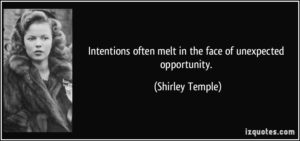
Robert Burns, in his poem To a Mouse, said, “The best laid schemes o’ mice an’ men / Gang aft a-gley.” Most often this is translated as “The best laid plans of mice and men often go awry.” How often hasn’t this been true of long-range strategic plans? After all, who can honestly guarantee what is going to happen over the next few years?
Does the possibility of unexpected challenges and opportunities mean that strategic planning is a waste of time? Would it make more sense to focus on responsive strategies to emerging issues instead and on how to execute them for maximum benefit? The case for such thinking has been argued and was the subject of an article I wrote a few months ago. In fact, it is a debate which continues – unnecessarily, in my mind.
Without rehashing the points I tried to make in that article, let me tell you two stories, both dealing with the same organization at different points in time. I happened to be involved with the organization as the chairman of the board during the first event, and later I was its President and CEO during the second event.
In the early 2000’s our board decided to engage outside counsel to guide us through a strategic planning process. The organization had not undertaken such an effort previously, and it followed a fairly traditional process involving staff research into strengths, weaknesses, opportunities and threats. It conducted focus groups around the Midwest to ascertain perceptions of mission and quality. It looked at data trends, revenue sources, and it came up with the usual assumptions about the economy, market share, employees and other variables. In short, it essentially crafted a strategic plan which projected the organization’s current status into a fairly stable future. It all looked good on paper.
 But a phone call in the summer of 2004 changed everything. A similar agency on the west coast was in trouble and asked for some assistance. Its CEO left under a cloud. Development revenue was way down. Debt load was too high. Its religious mission was being eroded. From 2004 to 2006, negotiations took place which eventually culminated in an affiliation that would ultimately result in a merger. The transfer of assets and membership took place in the summer of 2006 and overnight, the organization whose board I chaired doubled in size. Did we anticipate that opportunity when we did our strategic planning? No. And that is not surprising. Predicting such events is very difficult. But that unexpected opportunity still marked the single biggest milestone in the organization’s 105 year history, the impact of which is still being felt a decade later.
But a phone call in the summer of 2004 changed everything. A similar agency on the west coast was in trouble and asked for some assistance. Its CEO left under a cloud. Development revenue was way down. Debt load was too high. Its religious mission was being eroded. From 2004 to 2006, negotiations took place which eventually culminated in an affiliation that would ultimately result in a merger. The transfer of assets and membership took place in the summer of 2006 and overnight, the organization whose board I chaired doubled in size. Did we anticipate that opportunity when we did our strategic planning? No. And that is not surprising. Predicting such events is very difficult. But that unexpected opportunity still marked the single biggest milestone in the organization’s 105 year history, the impact of which is still being felt a decade later.
Most important for this discussion is the fact that we did not have a process in place for evaluating the opportunity from the perspective of the long-range vision and goals of the organization. We did not, for example, weigh the costs of such an acquisition against the other strategic priorities that we had set. We did not evaluate the labor issues or the impact of the merger on non-operating revenue. While it was argued at the time that the decision to merge was an ethical one (i.e., we just wouldn’t consider allowing the acquired company to go under), tools for evaluating the ultimate impact were not utilized. I’m not sure the outcome would have been different, but we certainly would have been better prepared for the longer-term challenges the merger brought about.
The second event occurred in 2008 and I have written about it before. Once the above-mentioned merger was imminent, I was asked to come to work at my agency as the merger integration project manager. In other words, I was to bring the two companies together into a cohesive whole. In the process, I was to facilitate a new strategic planning process which would lay out the preferred future for this new merged organization. Ten years ago I was already utilizing the approach that I have been advocating in steps one through seven of this planning process. In my opinion, we did everything right as far as articulating a coherent future for our organization. The board of directors ratified the new strategic plan at its February 2008 board meeting, the same meeting at which I was named to be the next CEO. The strategic plan was a work of art, a thing of beauty – at least as far as strategic plans went, and at least in my humble opinion.
 And then August came and the financial markets started to tank. Within four months we had lost 35% of the value of our endowment. States were already beginning to either hold or reduce Medicaid reimbursements. Our country was in a full-blown recession. And my beautiful strategic plan went up in smoke. All its assumptions were voided. All the goals and objectives around growth crashed into a heap. We were in survival mode and the new reality we had to face had very little to do with that preferred future we had so eloquently described in our strategic plan. The next six months were spent identifying and implementing survival strategies. Restructuring and right-sizing management was implemented and we ceased operations in areas where funding could not meet expenses. We put on hold plans to develop our campus and expand various programs. In short, we abandoned our lofty aspirations and hunkered down to weather the financial storm.
And then August came and the financial markets started to tank. Within four months we had lost 35% of the value of our endowment. States were already beginning to either hold or reduce Medicaid reimbursements. Our country was in a full-blown recession. And my beautiful strategic plan went up in smoke. All its assumptions were voided. All the goals and objectives around growth crashed into a heap. We were in survival mode and the new reality we had to face had very little to do with that preferred future we had so eloquently described in our strategic plan. The next six months were spent identifying and implementing survival strategies. Restructuring and right-sizing management was implemented and we ceased operations in areas where funding could not meet expenses. We put on hold plans to develop our campus and expand various programs. In short, we abandoned our lofty aspirations and hunkered down to weather the financial storm.
I tell these two stories to reinforce the truism that things happen that are beyond our control. A strategic plan, by its very nature, is a tool to control people, places and things in order to achieve a desired state of existence at some point in the future. Not everything can be controlled. Therefore, it seems prudent to consider ways to mitigate the risk to the organization without abandoning the overall strategic vision described in a strategic plan. In other words, how can decisions be made to deal with either catastrophe on the one hand or windfall opportunity on the other?
There are two ways to approach this question. The first is to have in place a rigorous process for managing and mitigating risk. That will be the subject of another article. The second is to develop decision-making criteria for addressing such unexpected events WITHIN THE CONTEXT OF THE STRATEGIC PLAN! If you have followed the first seven steps, you will have a detailed picture of your preferred future. The plan is high-level. It is visionary. It also has measurable goals and it is annually reviewable. It also is the vehicle through which annual initiatives can be developed. But most important, it articulates a set of beliefs and values about the future which can be translated into decision-making criteria. Such a process has been developed by David LaPiana and was described in greater detail in the afore-mentioned article. Developing four or five such criteria affords the organization a rational basis for evaluating events and making judgments about possible responses that are in alignment with overarching strategic goals.
Let me illustrate with an example. Let’s say that the organization decides that the following criteria are of greatest importance when it comes to building responsive strategies:
- the strategy must support or advance the mission,
- the strategy must contribute to competitive advantage,
- the strategy must enhance the bottom line financially,
- and the strategy must improve the organization’s image with respect to quality of service.
Hindsight, of course, is always 20/20, but let’s apply these criteria to both of the events I described earlier. Would we have proceeded with the merger had we employed this screening device? The affiliation certainly allowed us to advance our mission. Giving us a national scale of operations afforded us a competitive advantage over smaller, more regional organizations. The affiliation certainly gained attention from funders and trade associations. And because we built into the merger integration process commitments to a philosophy of quality service delivery, the merger definitely helped us enhance our image for providing exceptional service.
 But did we fully understand the implications of the decision for the larger goals of the organization? The impact on the organization’s finances was something else. Hoped-for expansion of the donor data-base did not materialize. Fund-raising could not keep up with a growing loss from operations. Promises to bring wages and benefits into alignment with the parent company only increased the cash-flow problem. I won’t say that the criterion related to financial impact would have been a deal-killer, but I do think it may have conditioned our negotiations in a way that would have lessened the negative impact. All-in-all, I believe the merger was the right thing to happen, but having such a screening mechanism in place would have influenced how we structured the deal.
But did we fully understand the implications of the decision for the larger goals of the organization? The impact on the organization’s finances was something else. Hoped-for expansion of the donor data-base did not materialize. Fund-raising could not keep up with a growing loss from operations. Promises to bring wages and benefits into alignment with the parent company only increased the cash-flow problem. I won’t say that the criterion related to financial impact would have been a deal-killer, but I do think it may have conditioned our negotiations in a way that would have lessened the negative impact. All-in-all, I believe the merger was the right thing to happen, but having such a screening mechanism in place would have influenced how we structured the deal.
And then there was the recession. Protecting the mission in the face of calamitous financial times was paramount and we worked hard to not compromise the quality of the services we provided. In fact, we were adamant that no strategy would negatively affect direct support. Strategies we did employ, therefore, we aimed a “right-sizing” to make sure that nothing interfered with mission and quality. Even when we had to announce closure of programs in a state which just would not reimburse at a break-even rate, messaging to the media was based on our uncompromising commitment to quality. So, even though we didn’t have a realistic strategic plan, we did develop, out of necessity, a set of decision guides that allowed us to remain true to who we were and to respond to the deepening financial crisis quickly and effectively.
The fear of having to face unanticipated challenges and opportunities and not having rational tools to aid decision-making is the most pressing concern of most CEOs I have the opportunity to work with. In fact, they tell me often that they can’t wait to get through the larger tasks of strategic planning so they can develop screening criteria to deal with such events. But I tell them, as I am telling you now, that building the overall strategic framework FIRST is the necessary prerequisite to creating screening criteria. Making decisions in the face of the unexpected twists and turns of life requires a meta-vision, an overarching direction, a high-level position toward which the organization is moving. The strategic plan is the vehicle for articulating that vision. Strategy screens are the tools for making immediate decisions about unanticipated events within the context of the overall plan.
Here’s an image that may help you visualize what I’ve been talking about. Think of the strategic plan as driving on an eight-lane freeway. You have calculated the ending point, how long it should take, and what your destination looks like. Annual iterations of the rolling strategic plan may suggest decisions such as taking a different route to save time or stopping for gas or coffee. Strategy decisions which are required to deal with unanticipated events can be thought of as being similar to making a lane change, deciding to speed up or slow down, or pulling over to fix a flat tire. You can see the relationship of each level of decision-making to the others.
When I have finished writing this ten-part series, I am going to share a schematic which visually depicts this ten-step process. You’ll want to stay tuned!
I am also planning to turn this model into a five-part video course which you and your board can use to work through a coherent approach to strategic planning.
In the meantime, your reactions and comments are always welcomed.




